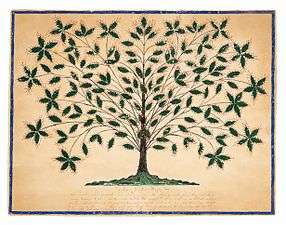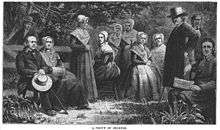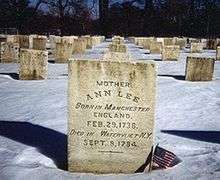Ann Lee
| Ann Lee | |
|---|---|
| Born |
29 February 1736 Manchester, England |
| Died |
8 September 1784 (aged 48) Watervliet, New York, U.S. |
| Other names | Ann Elizabeth Lees |
| Religion | Shaker |
| Parent(s) | John Lees |
 |
| Topics |
|---|
|
| Notable people |
|
Ann Lee (29 February 1736 – 8 September 1784), commonly known as Mother Ann Lee, was the leader of the United Society of Believers in Christ's Second Appearing, or Shakers.
In 1774 Ann Lee and a small group of her followers emigrated from England to New York. After several years, they gathered at Niskayuna, renting land from the Manor of Rensselaerswyck, Albany County, New York (the area now called Colonie). They worshiped by ecstatic dancing or "shaking", which dubbed them as the Shakers. Ann Lee preached to the public and led the Shaker church at a time when few women were religious leaders.[1]
Early history
Ann Lee was born in Manchester, England, and baptized privately at Manchester Cathedral on 1 June 1742,[2] at the age of 6. Her parents were members of a distinct branch of the Society of Friends, and too poor to afford their children even the rudiments of education.[3] Ann Lee's father, John Lees, was a blacksmith during the day, and a tailor at night. It is probable that Ann Lee's original surname was Lees, but somewhere through time it changed to Lee. Little is known about her mother other than she was a very religious woman. When Ann was young she worked in a cotton factory, then she worked as a cutter of hatter's fur, and later as a cook in a Manchester infirmary.
In 1758 she joined the Wardley's, an English sect founded by Jane and preacher James Wardley; this was the precursor to the Shaker sect.[4] She believed in and taught her followers that it is possible to attain perfect holiness by giving up sexual relations. Like her predecessors, the Wardleys, she taught that the shaking and trembling were caused by sin being purged from the body by the power of the Holy Spirit, purifying the worshiper.
Beginning during her youth, Ann Lee was uncomfortable with sexuality, especially her own. This repulsion towards sexual activity continued and manifested itself most poignantly in her repeated attempts to avoid marriage and remain single. Eventually her father forced her to marry Abraham Stanley. They were married at Manchester Cathedral on 5 January 1761.[5] She became pregnant four times, all of her children died during infancy. Her difficult pregnancies and the loss of four children were traumatic experiences that contributed to Ann Lee's dislike of sexual relations.[6] Lee developed radical religious convictions that advocated celibacy and the abandonment of marriage, as well as the importance of pursuing perfection in every facet of life. She differed from the Quakers, who, though they supported gender equality, did not accept forbidding sexuality within marriage.
Rise to prominence
In England, Ann Lee rose to prominence by urging other believers to preach more publicly concerning the imminent second coming, and to attack sin more boldly and unconventionally. She spoke of visions and messages from God, claiming that she had received a vision from God the message that celibacy and confession of sin are the only true road to salvation and the only way in which the Kingdom of God could be established on the earth. She was frequently imprisoned for breaking the Sabbath by dancing and shouting, and for blasphemy.[7]
She claimed to have had many miraculous escapes from death. She told of being examined by four clergymen of the Established Church, claiming that she spoke to them for four hours in 72 tongues.[8]
While in prison in Manchester for 14 days, she said she had a revelation that "a complete cross against the lusts of generation, added to a full and explicit confession, before witnesses, of all the sins committed under its influence, was the only possible remedy and means of salvation." After this, probably in 1770, she was chosen by the Society as "Mother in spiritual things" and called herself "Ann, the Word" and also "Mother Ann." After being released from prison a second time, witnesses say Mother Ann performed a number of miracles, including healing the sick.[9]
Lee eventually decided to leave England for America in order to escape the persecution (i.e. multiple arrests and stays in prison) she experienced in Great Britain.[7]
Move to America

In 1774 a revelation led her to take a select band to America. She was accompanied by her husband, who soon afterwards deserted her. Also following her to America were her brother, William Lee (1740–1784); Nancy Lee, her niece; James Whittaker (1751–1787), who had been brought up by Mother Ann and was probably related to her; John Hocknell (1723–1799), who provided the funds for the trip; his son, Richard; James Shepherd, and Mary Partington. Mother Ann and her converts arrived on 6 August 1774, in New York City, where they stayed for nearly five years. In 1779 Hocknell leased land at Niskayuna, in the township of Watervliet, near Albany, and the Shakers settled there, where a unique community life began to develop and thrive.[7]
During the American Revolution, Lee and her followers maintained a stance of neutrality. Maintaining the position that they were pacifists, Ann Lee and her followers did not side with either the British or the colonists.
Ann Lee opened her testimony to the world's people on the famous Dark Day in May 1780, when the sun disappeared and it was so dark that candles had to be lighted to see indoors at noon.[10] She soon recruited a number of followers who had joined the New Light revival at New Lebanon, New York, in 1779, including Lucy Wright.
Beginning in the spring of 1781 Mother Ann and some of her followers went on an extensive missionary journey to find converts in Massachusetts and Connecticut. They often stayed in the homes of local sympathizers, such as the Benjamin Osborn House near the New York - Massachusetts line. There were also songs attributed to her which were sung without words.[11]
The followers of Mother Ann came to believe that she embodied all the perfections of God in female form,[12] and was revealed as the "second coming" of Christ.[13] The fact that Ann Lee was considered to be Christ's female counterpart was unique. She preached that sinfulness could be avoided by not only treating men and women equally, but also by keeping them separated so as to prevent any sort of temptation leading to impure acts. Celibacy and confession of sin were essential for salvation.[12]
Ann Lee's mission throughout New England was especially successful in converting groups who were already outside the mainstream of New England Protestantism, including followers of Shadrack Ireland. To the mainstream, however, she was too radical for comfort.[14] Ann Lee herself recognized how revolutionary her ideas were when she said, "We [the Shakers] are the people who turned the world upside down."
Unfortunately, the Shakers were sometimes met by violent mobs, such as in Shirley, Massachusetts, and Ann Lee suffered violence at their hands more than once. Because of these hardships Mother Ann became quite frail; she died on 8 September 1784, at the age of 48.[7]

She died at Watervliet and is buried in the Shaker cemetery located in the Watervliet Shaker Historic District.[15]
It is claimed that Shakers in New Lebanon, New York experienced a 10-year period of revelations in 1837 called the Era of Manifestations. It was also referred to as Mother Ann's Work.[16]
Legacy
Ann Lee is memorialized in:
- Judy Chicago's The Dinner Party[17]
- the (afterword of the) novel A Maggot
See also
References
- ↑ In addition to Ann Lee, only nine women preachers have been identified before 1800. Catherine A. Brekus, Strangers and Pilgrims: Female Preaching in America, 1740–1845 (Chapel Hill: University of North Carolina Press, 1998), 343–46.
- ↑ MS 12/1, Manchester Cathedral Archive
- ↑
 Ripley, George; Dana, Charles A., eds. (1879). "Lee, Ann". The American Cyclopædia.
Ripley, George; Dana, Charles A., eds. (1879). "Lee, Ann". The American Cyclopædia.
- ↑ Campion, Nardi Reeder (1976), Ann the Word: The Life of Mother Ann Lee, Founder of the Shakers, Boston: Little, Brown and Company, ISBN 978-0-316-12767-7
- ↑ MS 13/3, Manchester Cathedral Archive
- ↑ Kern, Louis J. (1981). An Ordered Love: Sex Roles and Sexuality in Victorian Utopias: The Shakers, the Mormons, and the Oneida community. Chapel Hill: University of North Carolina Press. ISBN 978-0-8078-1443-7.
- 1 2 3 4 Richard Francis, Ann the Word: The Story of Ann Lee, Female Messiah, Mother of the Shakers, The Woman Clothed with the Sun (New York: Arcade Publishing, 2000).
- ↑ Foner, Eric; Garraty, John A., eds. (1991). "Ann Lee". American History Companion: The Reader's Companion to American History. Houghton Mifflin. p. 646. ISBN 978-0-395-51372-9.
- ↑ Answers.com Mother Ann Lee (section Britannica Concise Encyclopedia: Ann Lee)
- ↑ Francis, Ann the Word, 130–31
- ↑ Hall, Roger L. (2006). A Guide to Shaker Music - With Music Supplement. 6th ed. Stoughton, MA: Pine Tree Press. External link in
|publisher=(help) - 1 2 3 Rufus Bishop and Seth Youngs Wells, comps., Testimonies of the Life, Character, Revelations and Doctrines of our Ever Blessed Mother Ann Lee (Hancock, Mass.: J. Talcott and J. Deming, Junrs., 1816); Seth Youngs Wells, comp., Testimonies Concerning the Character and Ministry of Mother Ann Lee (Albany, N.Y.: Packard and Van Benthuysen, 1827).
- 1 2 Frederick William Evans. Shakers: Compendium of the Origin, History, Principles, Rules and Regulations, Government, and Doctrines of the United Society of Believers in Christ's Second Appearing : with Biographies of Ann Lee, William Lee, Jas. Whittaker, J. Hocknell, J. Meacham, and Lucy Wright. Appleton; 1859. p. 26.
- ↑ Brekus, Strangers and Pilgrims: Female Preaching in America, 1740–1845, 343–46.
- ↑ Landmarks of American women's history, Chapter: Watervliet Shaker Historic District, Page Putnam Miller, Oxford University Press US, 2003, pp. 36 ff.
- ↑ Aune, Michael Bjerknes; DeMarinis, Valerie M. (1996). Religious and Social Ritual: Interdisciplinary Explorations. SUNY Press. p. 105. ISBN 0-7914-2825-7.
- ↑ "Ann Lee". The Dinner Party: Heritage Floor. Brooklyn Museum. Retrieved 4 June 2012.
Further reading
- Campion, Nardi Reeder. Mother Ann Lee: Morning Star of the Shakers Publisher: UPNE. 1990. ISBN 0874515270
- Stein, Stephen J. The Shaker Experience in America: A History of the United Society of Believers (Yale University Press, 1992). ISBN 0300059337
 Hager, Jacob Henry (1892). "Lee, Ann". Appletons' Cyclopædia of American Biography.
Hager, Jacob Henry (1892). "Lee, Ann". Appletons' Cyclopædia of American Biography. "Lee, Ann". Encyclopædia Britannica (11th ed.). 1911.
"Lee, Ann". Encyclopædia Britannica (11th ed.). 1911. Rigg, James McMullen (1892). "Lee, Ann". In Lee, Sidney. Dictionary of National Biography. 32. London: Smith, Elder & Co.
Rigg, James McMullen (1892). "Lee, Ann". In Lee, Sidney. Dictionary of National Biography. 32. London: Smith, Elder & Co. - Claus Bernet (2002). "Ann Lee". In Bautz, Traugott. Biographisch-Bibliographisches Kirchenlexikon (BBKL) (in German). 20. Nordhausen: Bautz. cols. 899–911. ISBN 3-88309-091-3.
External links
 Quotations related to Ann Lee at Wikiquote
Quotations related to Ann Lee at Wikiquote